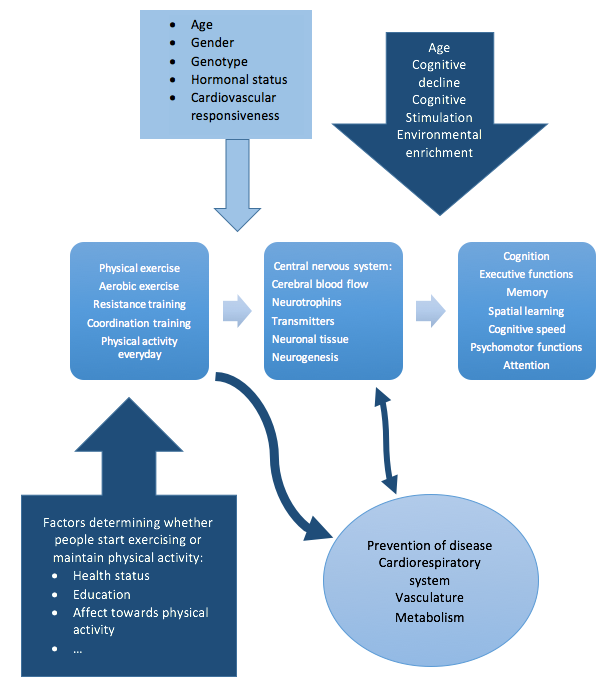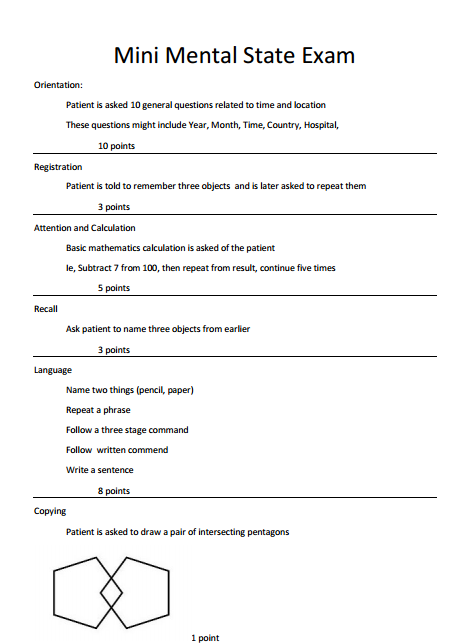Contents
Exercise and Cognition
Introduction
It has long been acknowledged across a variety of disciplines that physical exercise is beneficial for both physical and mental health, however, in recent years scientists have developed techniques to measure these benefits in a systematic and controlled manner. Improvements made to general health include; increase in muscle mass and aerobic capacity (Bouaziz et al., 2017). There are also numerous studies detailing the benefits awarded to mental health. This essay will focus on the beneficial effects on cognition in particular.
Cognition includes any mental activities which encompass the ability to reason, think and learn. It also refers to memory formation. In 2017, Dessimoz described cognition as the main faculty that the brain supports. It is the ability to make the correct decisions and to deliver the right information. Physiological markers such as Brain Derived Neurotropic Factor (BDNF), angiogenesis and neurogenesis will be discussed in this essay to examine the effects of different types of physical exercise on cognition in both humans and animals.
The type of physical activity undertaken, and the different neurogenetic changes that this may account for, will also be discussed. For example, the effects of a cardiovascular fitness programme may differ from that which occurs when partaking in a sport, such as high skill level sports (Ermutlu, 2014). Duration, intensity, timing and the use of exercise as a treatment for cognitive impairment also have varying effects on neurogenesis in both animals and humans. The aim of this essay is to discuss and review the beneficial effects on cognition of certain types of exercise, in both animals and humans, and to determine it’s use as a treatment for cognitive impairment.
|
Physiological Markers
BDNF
In reviewing papers, one particular marker, a neurotrophin, which continuously appeared was brain derived neurotropic factor (BDNF). A neurotrophin is a protein which functions in maintaining the development, survival and functions of neurons in the central nervous system and peripheral nervous system (Sahay et al., 2017). It is significant in relation to measuring cognition because increased levels have been found to advance learning and sustain cognitive functions by increasing cerebral blood flow, improving synaptic plasticity and acting as a neuroprotective agent and improved neuroelectric functionality (Haapala, et al. 2013). By challenging the brain with physically demanding exercises, enhanced mental performance and learning can be observed. Moreover, as well as increasing levels of BDNF, exercise mobilizes gene expression profiles that would be predicted to benefit brain plasticity processes (Ermutlu et al., 2014). This contributes to neurogenesis.
Angiogenesis
It has been established in numerous animal studies that different brain adaptations can be initiated by different forms of physical exercise. Endurance exercise is shown to generate blood vessels and increase capillary density (angiogenesis) and thereby increase cerebral blood flow (Haapala et al. 2013). BDNF has also been found to stimulate angiogenesis in both human and animal studies.
The growth and development of nervous tissue (neurogenesis) seems to be coupled with angiogenesis (Kempermann et al., 2010). One review by Voelcker-Rehage et al. (2013) related changes in angiogenesis and cerebral blood volume to changes in VO2 max. This suggests that differences in brain activity might be instigated by a greater supply of oxygen. Prolonged endurance exercises, such as cardiovascular and resistance training, require an increase in both glucose and oxygen because of the increased metabolic demand of the active neurons. Therefore, increased physical exercise is closely linked to enhanced blood supply. Another study that the increase of capillary densities indicates a shorter diffusion distance for oxygen from blood vessels to neurons, thus promoting metabolism of neurons. It was concluded that angiogenesis in the cerebral regions is a direct result of amplified exposure to cardiovascular exercise (Bullitt et al., 2009).
Animal Studies
Numerous studies have been conducted on the effects of exercise on cognition in animals. Voluntary wheel running is the most commonly used experimentation model used in rodents to study exercise induced nerual changes and beneficial changes in behaviour (Hotting et al., 2013). Dogs are also commonly used for cognitive related studies, in particular those examining dementia and Alzeimher’s Disease, as they show a similar tendency to suffer from cognitive decline with age, as humans do (Cotman et al., 2007).
Animal studies have suggested that exercise induces changes in the nervous system that are both structural and functional. Hotting et al. (2013) detailed these changes in 2013. They included; an increase in angiogenesis and andritic spine density, enhanced long term potentiation and an augmented release of growth factors such as BDNF and IGF-1. They also stated that exercise effects neurotransmitter systems such as increasing the levels of serotonin, noradrenaline and acetlycholine. One of the most reported structural changes in studies using animals is the increased rate of neurogenesis within the hippocampus, specifically in the dentate gyrus. This is a particualry important area of the brain in the formation of new memories.
It may be disputed that some of the beneficial changes found in animal studies are due to the enrichment of the ennvironment which has also been shown to improve cognitive function (Cotman et al., 2007). Neurons are lost in the hippocampus as animals age but according to the aforementioned study, beagles living in an enriched environment, which included access to toys, kennel mates and a regular exercise regime, had a notably larger amount of a certain subset of hilar neurons. However, it can be argued that many of the animal studies conducted in this field cannot be equated to the effects found in wild animals or, indeed, humans, as the animals, often rats or mice, are kept in unnatural conditions with little to no environmental enrichment. The introduction of exercise can be considered an environmental enrichment, or a novel activity, and may have an effect on the results (Hatchard et al., 2014).
Type of exercise
Animals
Exercise type
The type of exercise is also an important parameter when comparing results. Both voluntary wheel running and forced wheel running have been shown to improve neurogenesis, learning and memory in mice. In voluntary wheel running, the animal may run whenever they please, whereas foced wheel running consists of having the animal run on the treadmil within strict experimental designs such as duration, intensity and time (Li et al., 2013). The latter is considered to be a more objective meausrement of results.
Another study explained that results are effected by the time of day at which exercise takes place and also the intensity of said exercise. Regular exercise has also been proven to be more beneficial to neurogenesis in animal studies, as it has in humans. In this study mice were divided into groups including; a control group of mice which did not partake in the exericse programme, a group of regular duration runners, a group of irregular duration runners and a group of mice that ran at irregular times during the day. Neurogenesis in the dentate gyrus was also examined in this study. Corticosterone levels were taken to determine stress levels as high levels can counteract neurogenesis and treadmill running has been shown to increase stress levels. They found that the higher intensity mice (3 hours of running) had higher levels of neurogenic activity in comparison to the lower intensity mice (1 hour of running), which were actually shown to have a higher level of cell neurogenesis. The control group of mice showed no changes. This suggests that excessive or inadequate levels of exercise have negative effects on neurogenesis. They also found that regular treadmill running was more beneficial to spatial awareness and memory formation (Li et al., 2013).
|
BDNF as a Physiological Marker
BDNF has been shown to be the principal signalling molecule in the hippocampus and cortex of the brain using animal studies. It contributes to neuronal survival and synaptic plasticity and long term potentiation, which is important for learning and memory. Evidence in animal studies has suggested that exercise can have impressive effects on BDNF levels. One week of wheel running in rats has been shown to increase levels by 1.5 times (Cotman et al., 2007). These results were also shown to be a reliable measurement in animal studies as its results were found to be independent of housing conditions (Hatchard et al., 2014). This may eliminate some of the effects of environmental enrichment. In a study where mice were expected to locate a platform, a test of spatial awareness and memory, BDNF levels were measured in mice undertaking an exercise routine. Those such mice, which also displayed higher levels of the molecule, were shown to locate the platform more often in comparison to the non-exercising, control mice. Another group of mice were then treated with a BDNF signal blocker (TrKB-IgG chimera) and these mice showed no improvements in spatial awareness and memory levels. BDNF protein levels were shown to increase after only one week of wheel running and the effects were found to continue for up to 3 months (Cotman & Berchtold, 2007).
Human Trials
From studies conducted on humans, it is apparent that certain parts of the brain are activated and enhanced by cardiovascular activity. This suggests that other types of physical exercise may trigger different parts of the brain. A noteworthy study by Ermutlu et al. (2014), compared different types of exercise on brain electrical activity. Electroencephalography (EEG) scans were recorded in professional dancers and professional fast ball sports athletes and even though these particular exercise types are comparable based on physical effort, they have very different cognitive and sensory motor features due to the divergent skills required. This is strikingly apparent when comparing the two sets of EECs. The plasticity induced differences of physical exercise coupled with the training effects of constant practice of skills over a prolonged period of time in fast ball sports and dancing may have additive effects on brain networks and functions.
In comparison to animal studies, levels of BDNF and other neurotrophins such as IGF-1, have been measured post-exercise in humans. The peripheral BDNF levels have been found to increase after an acute bout of physical exercise and to return to baseline levels within a few minutes to several hours (Hotting et al., 2013).
Treatment of Cognitive Impairments
Aerobic exercise (AE) can be defined as “planned, structured repetitive physical activity for extended periods and at a sufficient intensity to improve or maintain physical fitness” (Mackay-Lyons, 2013). Parameters of AE include; duration, intensity, frequency, mode and timing of exercise. Intensity level can be measured using perceived levels of exertion, heart rate or respiration rate (Hasan, 2016).
As previously mentioned, cognition is affected by aging, especially in terms of memory and attention. Executive function (EF), a set of behavioural processes including time management and the ability to pay attention, depends on the prefrontal cortex. The cortex reduces in size with age. Bonavita (2016) associates better cognitive performance amongst older people who have active, rather than sedentary lifestyles. Liu-Ambrose (2007) also highlights that cognitive impairments impede motor learning. It is important to understand the positive impact of exercise on cognitive impairments as this can help to increase independence, reduce disability and prevent institutionalisation amongst the elderly (Patel et al., 2002). Mahmadal Hasan (2016) states that after stroke, “cognitive health and the recovery of complex motor skills are intertwined”, which is important in terms of treatment planning. Commonly used measures of cognition in Irish and Australian hospitals include the Mini Mental State Exam (MMSE) and the Montreal Cognitive Assessment. These are questionaires that are used to track improvements in a patient’s level of cognition and their response to treatment, quickly and with high sensitivity. Forms of cognition significant to rehabilitation include : working memory, attention and executive function. Studies using neuroimagery show that there is a link between being fit in terms of cardiorespiratory and aerobic health, and brain structure and function, particularly in pre-cortical areas and areas where neural circuits related to EF are located.
|
Level of Intensity
Hasan et al (2009) compared the intensity of various programmes in his systematic review. It was found that programmes of low intensity did not show significant improvements on cognitive outcomes such as working memory. This study found that moderate intensity and combination programmes resulted in more substantial improvements in memory and learning. Moderate intensity exercise includes treadmill walking, overground walking and stationary cycling sessions, ranging from 20 to 60 minutes, depending on patients levels of perceived exertion. Interestingly, similar results were found by Cotman et al (2007) when comparing mice that were subjected to higher intensity exercise.
Combination Therapy
Combination therapy refers to other interventions used for stroke patients in terms of rehabilitation; including physiothrapy, speech and language and occupational therapy. Marzolini (2013) states that while there is little evicence to prove that AE alone will improve executive function in stroke patients, as a combination therapy, the results are very promising.
Gaps in research
Few studies have examined the effects of chronic exercise on cognition. This could be useful in a variety of ways for human athletes and animals in sport. Lack of control groups in many of these studies, as it would be unethical to deprive a patient of treatment for the sake of research, limited the findings of these studies. Similarly, in animal research, test subjects may alter the results, particularly in terms of their housing conditions. Experiments which exclude the negative effects of unnatural housing conditions would be beneficial in this area.
Conclusion
The use of markers such as BDNF have highlighted the effectiveness of physical exercise in improving and aiding cognitive function, by means of increasing both angiogenesis and neurogenesis. BDNF levels were found to be higher in exercising rodents than non-exercising rodents. It can be concluded from this that increased BDNF levels are an accurate evaluation of the beneficial changes in cognition. Also, there have been significant differences found between the cognitive changes stimulated by different types of exercises seen in both animal and human studies. In the same way physical exercise can aid cognition by means of neurogenesis and angiogenesis, it can also be used as a treatment and preventative measure in degenerative disorders. Physical exercise as a form of treatment for stroke sufferers and a pre-emptive action for aging adults will become more and more important in the coming years. With advances in technology and medical research the average age of death in western society is increasing. Age related degenerative disorders will therefore increase respectively unless measures are taken.
References
Bonavita, S., Tedeschi G, (2016). Physical Activity and the Aging Brain. Chapter 12 – Neural Structure, Connectivity, and Cognition Changes Associated to Physical Exercise, 1st ed. Arizona: Academic Press, 121-131.
Bouaziz, W., Vogela, T., Schmitta, E. et al (2017). Health benefits of aerobic training programs in adults aged 70 and over: a systematic review. Archives of Gerontology & Geriatrics, 69 (1), 110-127.
Bullitt, E., Rahman, F.N., Smith, et al (2009). The effect of exercise on the cerebral vasculature of healthy aged subjects as visualized by MR angiography. American Journal of Neuroradiology, 30 (10), 1857–1863.
Cotman, C.W & Berchtold, N.C. (2007). Physical activity and the maintenance of cognition: Learning from animal models. Alzeimer's & Dementia, 3 (2), 30-37.
Dessimoz, J.D. (2017). Reprint of Cognition, cognitics, and team action—Overview, foundations, and five theses for a better world. Robotics and Autonomous Systems, 90, 24-33.
Ermutlu, N., Yucesir I., Eskikurt G. (2014). Brain electrical activities of dancers and fast ball sports athletes are different. Cogn Neurodyn, 9 (2), 257–263.
Haapala, E., (2013). Cardiorespiratory Fitness and Motor Skills in Relation to Cognition and Academic Performance in Children – A Review. Journal of Human Kinetics 36, 55-68.
Hatchard, T., Ting, J.J., Messier, C. (2014). Translating the impact of exercise on cognition: Methodological issues in animal research. Behavioural Brain Research . 273 (1), 177-188.
Hötting, K., Röder, B. (2013). Beneficial effects of physical exercise on neuroplasticity and cognition Neuroscience and Biobehavioral Reviews 37, 2243-2257
Lia, H., Lianga, A., Guanc, F., et al (2013). Regular treadmill running improves spatial learning and memory performance in young mice through increased hippocampal neurogenesis and decreased stress. Brain Research, 1531, (1-8).
Liu-Ambrose, M., Pang, Y. C. and Eng, J. J., (2007). Executive function is independently associated with performances of balance and mobility in community-dwelling older adults after mild stroke: implications for falls prevention, Cerebrovascular Diseases, 23 (2-3), 203–210.
Mackay-Lyons, M., Macko, R., Eng, J. et al. (2013). AEROBICS: Aerobic exercise recommendations to optimize best practices in care after stroke, 2012, http://strokebestpractices.ca/wp-content/uploads/2013/07/AEROBICS-FINAL-July-2013.pdf.
Mahmudul Hasan, S. M., Rancourt, S. N., Austin, M. W., Ploughman M., (2016) Defining Optimal Aerobic Exercise Parameters to Affect Complex Motor and Cognitive Outcomes after Stroke: A Systematic Review and Synthesis, Neural Plasticity, Article ID 2961573, 12 pages, 2016. doi:10.1155/2016/2961573.
Marzolini, S., McIlroy, W., Brooks, D. (2013). The effects of an aerobic and resistance exercise training program on cognition following stroke, Neurorehabilitation and Neural Repair, 27 (5), 392-402.
Images
Fig 1. Flowchart, O'Sullivan, H.
Fig 2. Exercise wheel, www.wikimedia.com (public domain)
Fig 3. Mini Mental State Exam example, Brody J.



